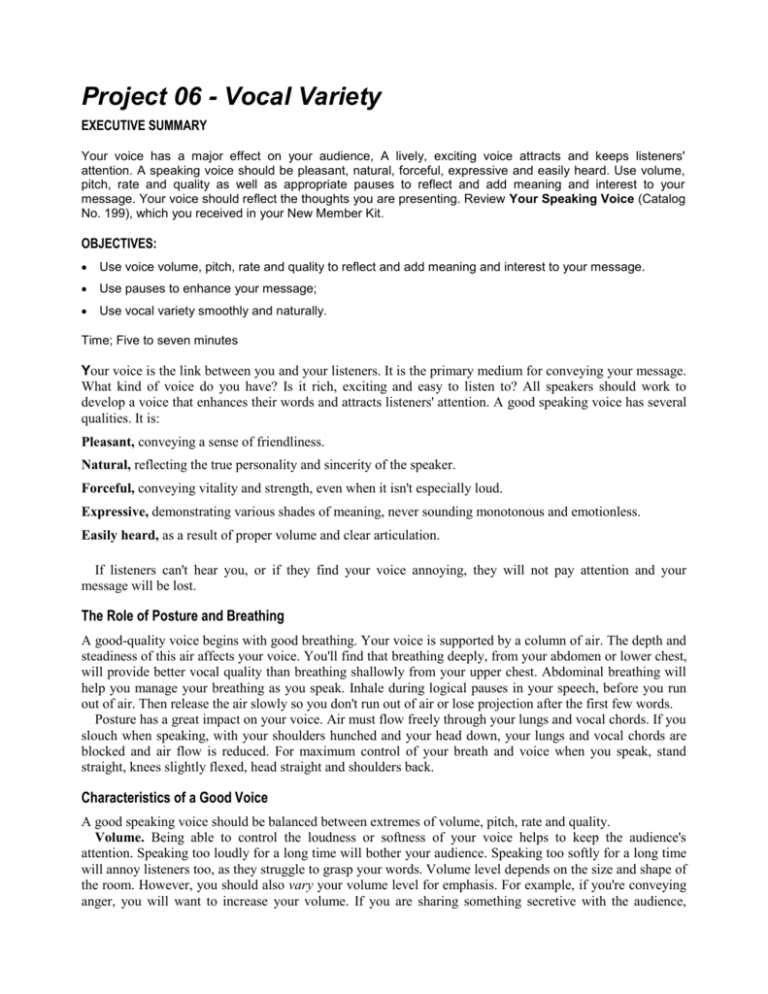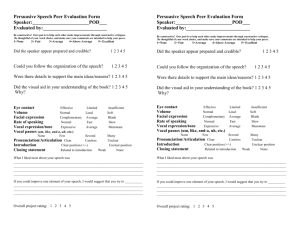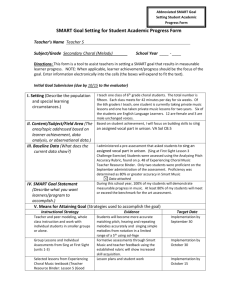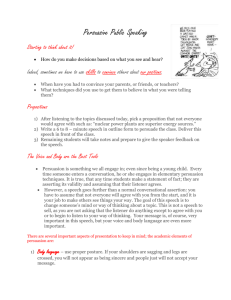Vocal Variety - Westside Toastmasters, for public speaking and
advertisement

Project 06 - Vocal Variety EXECUTIVE SUMMARY Your voice has a major effect on your audience, A lively, exciting voice attracts and keeps listeners' attention. A speaking voice should be pleasant, natural, forceful, expressive and easily heard. Use volume, pitch, rate and quality as well as appropriate pauses to reflect and add meaning and interest to your message. Your voice should reflect the thoughts you are presenting. Review Your Speaking Voice (Catalog No. 199), which you received in your New Member Kit. OBJECTIVES: Use voice volume, pitch, rate and quality to reflect and add meaning and interest to your message. Use pauses to enhance your message; Use vocal variety smoothly and naturally. Time; Five to seven minutes Your voice is the link between you and your listeners. It is the primary medium for conveying your message. What kind of voice do you have? Is it rich, exciting and easy to listen to? All speakers should work to develop a voice that enhances their words and attracts listeners' attention. A good speaking voice has several qualities. It is: Pleasant, conveying a sense of friendliness. Natural, reflecting the true personality and sincerity of the speaker. Forceful, conveying vitality and strength, even when it isn't especially loud. Expressive, demonstrating various shades of meaning, never sounding monotonous and emotionless. Easily heard, as a result of proper volume and clear articulation. If listeners can't hear you, or if they find your voice annoying, they will not pay attention and your message will be lost. The Role of Posture and Breathing A good-quality voice begins with good breathing. Your voice is supported by a column of air. The depth and steadiness of this air affects your voice. You'll find that breathing deeply, from your abdomen or lower chest, will provide better vocal quality than breathing shallowly from your upper chest. Abdominal breathing will help you manage your breathing as you speak. Inhale during logical pauses in your speech, before you run out of air. Then release the air slowly so you don't run out of air or lose projection after the first few words. Posture has a great impact on your voice. Air must flow freely through your lungs and vocal chords. If you slouch when speaking, with your shoulders hunched and your head down, your lungs and vocal chords are blocked and air flow is reduced. For maximum control of your breath and voice when you speak, stand straight, knees slightly flexed, head straight and shoulders back. Characteristics of a Good Voice A good speaking voice should be balanced between extremes of volume, pitch, rate and quality. Volume. Being able to control the loudness or softness of your voice helps to keep the audience's attention. Speaking too loudly for a long time will bother your audience. Speaking too softly for a long time will annoy listeners too, as they struggle to grasp your words. Volume level depends on the size and shape of the room. However, you should also vary your volume level for emphasis. For example, if you're conveying anger, you will want to increase your volume. If you are sharing something secretive with the audience, lower the volume. Pitch. The pitch of a sound is how high or low it is on the musical scale. Vary your pitch as you speak droning on in a monotone voice will quickly put listeners to sleep, and speaking in a squeaking voice will make them want to cover their ears. You should adapt the pitch of your voice to the material you are presenting. For example, a high pitch conveys excitement and enthusiasm, while a low pitch indicates sadness or thoughtfulness. Rate. This is the number of words you speak per minute. Speak too fast and your audience will not be able to keep up with you. Speak too slowly and your listeners will lose interest. You want to speak fast enough so that people have to pay attention, but slow enough that they can digest what you are saying. The most effective speaking rate is approximately 125 -160 words a minute. You should vary the rate, moving quickly through some of the material but slowing to emphasize important information or to communicate a complex idea. Quality. Your voice should convey friendliness, naturalness and confidence, and be enjoyable and pleasant to the ears. Listen to yourself on tape. Does your voice sound harsh, breathy, shrill, thin or nasal? You can improve it by relaxing, eliminating any tension from your voice. Silence Can Be Golden At times you won't want to use your voice. Welltimed silences or pauses add impact to your words and are a powerful speaking technique. A pause can be used to: Emphasize your main points. A moment of silence before a statement tells listeners that you are about to say something important. A brief pause after you make a statement tells listeners that what you just said is important. Breathe. Appropriate pauses are your opportunity to inhale. Punctuate. Pauses often serve as punctuation, telling listeners that you have ended a sentence or thought. Attract attention. When you feel that listeners are distracted, pause. Your silence will attract their attention back to you. Be Expressive Your voice should be expressive, showing a wide range of emotion. An expressive voice adds more meaning to the words you use, enhances your message and adds interest for your audience. Read these passages aloud using the tone of voice appropriate to each: I appreciate all you have done for me, and I hope to return the favor some day. (Simple, honest statement, or sarcasm.) Kindness! Do you call that kindness? I wouldn't treat a stray dog the way you've treated me! (resentment, anger, unfriendliness.) If each of us do one kind thing for someone else every day, we could help make the world a better place to live. (Deep feeling of earnestness and conviction.) Notice how your tone and effect vary with the different thoughts you express. See how easy it is to change the meaning by changing your emphasis. As another experiment, call a friend on the telephone and talk for several minutes on some topic of mutual interest. Vary your tone of voice, rate, pitch and volume. Use pauses to emphasize a point or arouse interest in what you will say next. At the same time, keep your vocal experimentation within the context of normal conversation. The Value of Rehearsal Like body language, your speaking voice should be natural and consistent with the meaning of the words being spoken. Achieving a speaking voice that is comfortable for you and enjoyable for the audience takes thought and practice. After you have drafted your speech, read it and note any places where you can vary the rate, pitch, volume and vocal quality, or pause to add emphasis and meaning. Speak clearly and project your voice. Try several different methods to see which one is most effective. Match vocal variety to your words. You should be compelled to change your voice when your thought or words require it. Don't worry if at first your efforts at vocal variety are awkward. The more you rehearse your speech and become familiar with your voice, the more comfortable you will become. If you have access to a tape recorder, use it in rehearsals to help you improve. Your Assignment This speech focuses on vocal variety. You are to: Choose a subject that calls for vocal variety. It could be a topic that requires a display of emotion, one that enables you to quote or imitate different tones of voice or manners of speaking, or one that involves a great deal of description. Use a voice that is pleasing to listen to, with proper balance of volume, pitch and rate. Use pauses to enhance your message. Use your voice to reflect and add meaning and interest to the thoughts you are presenting. Be sure to incorporate what you've learned in previous projects about purpose, organization, word usage and body language, and use appropriate suggestions from the evaluations you received. As you prepare your speech, review the Speaker's Checklist in Project 1 and Your Speaking Voice (Catalog No. 199), which you received in your New Member Kit. Evaluation Guide for Vocal Variety Title __________________________________________________________________________________________ Evaluator ____________________________________________________ Date _____________________________ NOTE TO THE EVALUATOR: The speaker is to use a voice that is pleasing to listen to, with proper balance of volume, pitch and rate, and use pauses to enhance his or her message. The speaker's voice should reflect and add meaning to the thoughts he or she is presenting. The speaker is to incorporate lessons learned in previous projects about purpose, organization, word usage and body language. In addition to your verbal evaluation, please complete this evaluation form by checking the appropriate space for each category. Add comments where praise is warranted or where you can offer specific suggestions for improvement. Topic Selection: __Facilitated vocal variety __Satisfactory __Could Improve Volume: __Excellent __Satisfactory __Too loud or soft Rate: __Excellent, varied __Satisfactory __Too fast or too slow Pitch: __Varied conversational __Satisfactory __Monotonous, artificial Quality: __Pleasant, friendly __Satisfactory __Harsh, monotonous Pauses: __Appropriate, effective __Satisfactory __Could Improve Expressiveness: __Conveyed emotion, meaning __Satisfactory __Could Improve Vocal Variety: __Enhanced speech __Satisfactory __Could Improve Organization: __Logical flow of ideas __Satisfactory __Should Improve Word Usage: __Vivid, descriptive, accurate __Satisfactory __Could Improve Body Language: __Natural, expressive __Satisfactory __Unnatural, distracting What could the speaker have done differently to make the speech more effective? What did you like about the speech?







